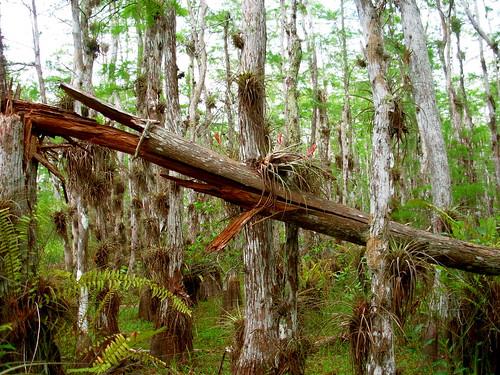
By Kathy Torres
What? How can a plant live without soil? Beneath the tree canopies in their native habitats across Central and South America, Mexico and the southern United States, Air Plants can be found growing on branches, rocks or other surfaces, thriving in the humidity and filtered sunlight. They typically have strap-like leaves growing in a rosette pattern with new growth emerging from the plant’s center. The foliage color may vary, from silver or green or even red, and it can be spiky or fuzzy. Some produce flowers in shades of red, pink or purple that last from a few days to a few months. Most air plants range from 2″ to 12″ tall.
Not to be confused with a parasite that can cause harm to its host, an Air Plant is considered an “epiphyte” using Greek terminology, for growing on top of a plant (epi = on top of; phyte = plant), gathering its nutrients from the air, water and debris, rather than soil. The roots attach without damage to the host plant. These unique, low maintenance beauties have become quite popular in recent years, making an attractive and interesting display, mounted (with fishing line) to a piece of driftwood, sitting or hanging in a clear glass bulb or other decorative container, or grouped together in a saucer or bowl as a centerpiece. Although it seems like an enclosed terrarium would be a good home, it’s likely the environment would be too wet, so don’t go there. As indicated earlier, soil is not necessary, so DO NOT UNDER ANY CIRCUMSTANCES PLANT AIR PLANTS IN DIRT!
There are hundreds of species and varieties of Air Plants, crossing many plant families. FYI… Spanish Moss and Staghorn Fern are actually Air Plants. The most common classification typically available in garden centers is Tillandsia, from the Bromeliad family. These are perfect for indoors or outdoors (except during winter). Here are a few currently in stock at Wingard’s.
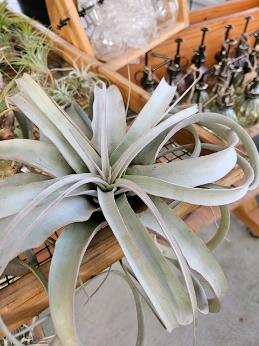
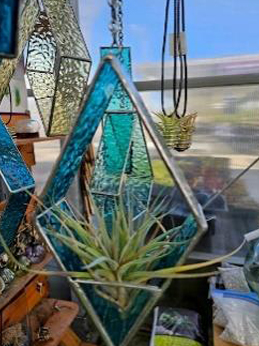
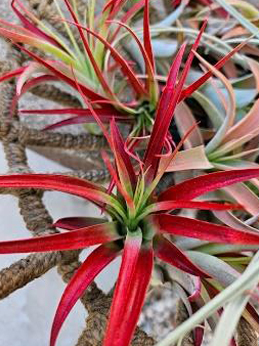

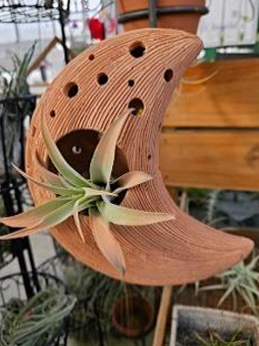
Requirements for Tillandsia
Requirements for Tillandsia are pretty simple… they like humidity, bright indirect light, regular watering and a little bit of fertilizer. There are a few mistakes that can be made, so here are the guidelines for success:
- Humidity – For placement indoors, select a spot in a kitchen, bathroom or laundry room, where the air is more humid. Avoid dry areas of the home and don’t put them near a heater or air conditioner vent. Air Plants prefer warm temperatures, however, they will do just fine in typical indoor temperatures (68 – 72 degrees). Keep them outside throughout the year, except during winter. They will love the hot, humid summer weather!
- Light – Air Plants need bright, indirect light, so it can be tricky to find a good spot to display them. The best place is a room with lots of windows, as long as the sun’s rays don’t shine directly on the plant(s). You can also use artificial grow lights or fluorescent lighting if you don’t have a great window option. Outdoors, try to place them in an area that is similar to their natural habitat, where they will receive indirect sunlight that is filtered through the trees. A bright porch that receives indirect sunlight is perfect. There are a few types of Air Plants that can thrive in shade, but most prefer light. Browning will occur and they will become “crispy critters” in the full sun. Even a little direct sun in the summertime here, will be too much.
- Water – Regular watering is critical, but it doesn’t take much. There are a couple of ways you can water Air Plants. Lightly mist 2 or 3 times a week, or dunk them for 20-30 minutes in a bowl of water once a week. If dunking, place the plant upside down on a paper towel afterwards to dry excess water. Too much water will cause rotting. If the plant feels “mushy” you have over-watered. If the tips turn brown, you may not be watering enough. Cut off the tips and alter your watering schedule. NOTE: Use rainwater or bottled drinking water for Air Plants. The salt in softened water will burn the air plants and tap water has minerals that can keep them from absorbing nutrients.
- Fertilizer – It’s not absolutely necessary to fertilize Air Plants, but if you want them to flourish (and bloom) add a bit of water soluble fertilizer in the mist or the water soak about once a month. Use a fertilizer for bromeliads and follow the directions.
One of the best characteristics of the Air Plant is the “mother” plant will produce “pups” if the plant is thriving. You know if this happens, you are doing everything right! The pups can be left alone or transplanted to form a new plant. To transplant, wait until the pup is about 1/3 the size of the mama. Just pinch and wiggle the pup to remove it. If it’s stubborn and does not release, simply take a small, alcohol-sanitized clipper and cut it out. The other revelation that the plant is healthy and thriving is a bloom. Blooms may appear in many bright, tropical colors, depending on the variety of Air Plant. Unfortunately, the plant from which the bloom appeared will die soon after. This is one good reason to leave the pups where they appear, to keep growth ongoing.
It’s too early to start planting in the yard, but it’s always a good time for a house plant (you can move it outside if you like when the weather warms up). Stop by Wingard’s and take a look at the latest shipment of Air Plants. Talk to Heidi in the Greenhouse if you need assistance in making your selection. For ideas on how to display these guys, check out this link AIR PLANT IDEAS. I think you will be surprised by what you can do with them, and how interesting, different and easy they can be.

